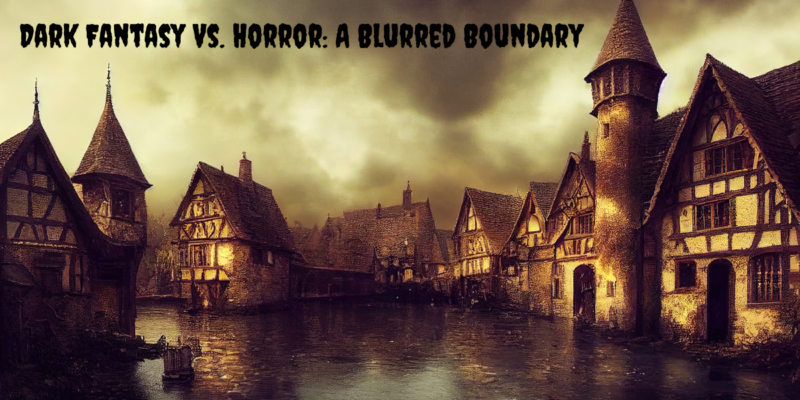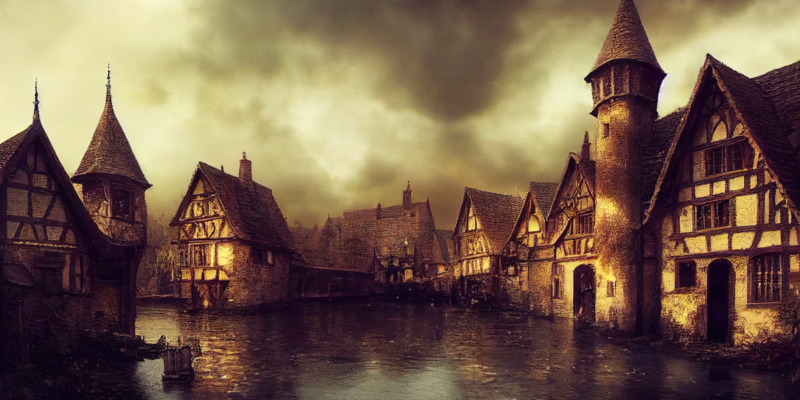


In the realm of speculative fiction, where imagination reigns supreme, two genres often intertwine and create an intriguing blend – Dark Fantasy and Horror. These two genres, though distinct in their elements and themes, frequently blur their boundaries, resulting in stories that are as enigmatic as they are compelling.
Before we delve into the blurred lines, it’s crucial to define each genre individually.
Dark Fantasy draws us into a world where fantastical elements and darker themes coalesce. Often filled with supernatural elements, moral ambiguity, and complex characters, these narratives create a realm where magic and dread meet. Think “Game of Thrones” by George R.R. Martin or “American Gods” by Neil Gaiman.
On the other hand, Horror focuses on instilling fear in its readers. Be it psychological horror, supernatural entities, or spine-chilling tales of the unknown, the central aim is to provoke a sense of fear, dread, or shock. From the haunting tales of H.P. Lovecraft to the psychological thrillers by Stephen King, horror has many facets.
The overlap between dark fantasy and horror lies in their shared exploration of darker themes and often supernatural elements. Both genres delve into our deep-rooted fears, often using elements of the unknown and the supernatural to create tension and unease.
Dark fantasy tends to use these elements in a broader narrative context, often set in a world vastly different from our own. The dark undertones and horrific elements are part of a larger tale, often centered around themes of power, conflict, and struggle.
Horror, by contrast, uses these elements primarily to evoke fear and dread, often in a setting and context that, while possibly including fantastical elements, is more closely focused on the horrific experiences of the characters.
A perfect example of this genre blending is “The Witcher” series by Andrzej Sapkowski. The stories, set in a deeply intricate fantasy world, are undeniably dark and frequently venture into the realm of horror with their nightmarish creatures and bleak storylines.
Similarly, the “Hellboy” graphic novels by Mike Mignola seamlessly blend elements of dark fantasy and horror. Hellboy, a demon brought to Earth, battles various supernatural horrors while grappling with his own demonic nature – a mix of the fantastical and horrific.
In the end, the division between dark fantasy and horror is often less a solid boundary and more a shifting point along a narrative continuum. Both genres explore our fears and nightmares – it’s often merely a matter of emphasis and intent that differentiates one from the other.
So, whether you enjoy the fantastical yet grim narratives of dark fantasy or the spine-chilling thrill that horror brings, you’re in for a treat when these two genres blur their lines. It’s in this overlapping space that some of the most compelling and thought-provoking stories come to life.
To illustrate the captivating blend of dark fantasy and horror, and the unique spaces where these genres intersect, let’s examine some exemplary works in these categories.
Finally, let’s look at a few notable works that successfully blur the lines between these two genres:
From these novels and series, it’s clear that there’s much to explore and enjoy in the realms of dark fantasy and horror, and especially in the space where they overlap. Whether you prefer a more fantastical narrative or something designed to terrify, there’s a wealth of stories that exist along the blurred boundary between these two genres. Happy reading!
Join thousands of readers getting free daily emails with the hottest new releases, limited-time promos, and hidden gems – before anyone else.
It's 100% free. No spam, just great books delivered daily.
Thanks for joining our newsletter! Want to dive even deeper into the world of books you love? Create a free CraveBooks reader account and unlock exclusive perks:
Connect directly with your favorite authors and discover new ones.
Be the first to know about new releases and exciting updates.
Share your thoughts and chat about books with a passionate community.
Get notified about special book updates, participate in giveaways where you can get fun items & books, and download free books – all without spending a dime!
It's the perfect way to enrich your reading journey and discover your next obsession. Join our community of avid readers today!
